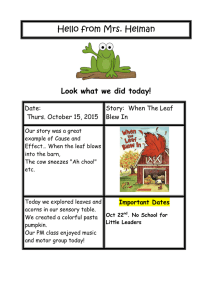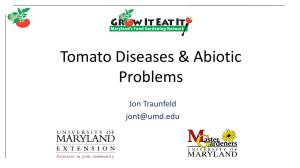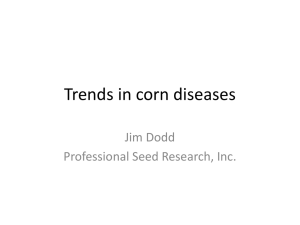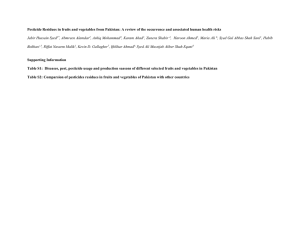Diagnosis and Prevention of Vegetable Diseases in Organic Systems
advertisement
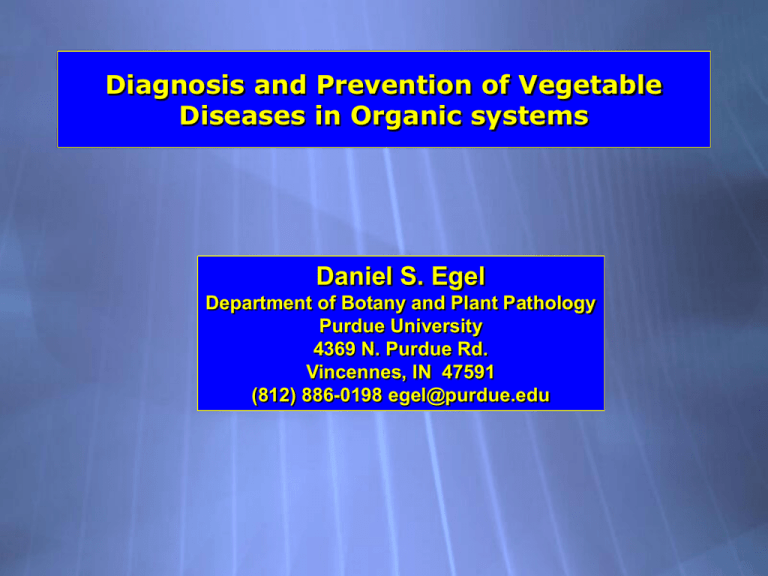
Diagnosis and Prevention of Vegetable Diseases in Organic systems Daniel S. Egel Department of Botany and Plant Pathology Purdue University 4369 N. Purdue Rd. Vincennes, IN 47591 (812) 886-0198 egel@purdue.edu Learn about what diseases are important for your crop/location Tomato Diseases Anthracnose Bacterial spot Canker Early blight Fusarium crown rot Fusarium wilt Gray mold Late blight Leaf mold Root knot Septoria Speck Timber rot TMV Verticillium Residue borne tomato diseases-rotations of 2-4 years and fall tillage critical Disease Maybe Seed borne Resistance Comments Anthracnose Yes No Bacterial spot/speck Yes Speck Canker Yes No Stake & mulch Early blight/ No Septoria No Late blight Yes Unusual in Indiana No Primarily greenhouse diseases Leaf mold/ gray mold No No Soil borne tomato diseases-rotations of more than 4 years and fall tillage critical Disease Maybe seed borne Resistance Comments Fusarium crown rot No No Fusarium wilt Yes Yes 3 races exist Phytopthora diseases No No Includes buckeye rot and root rot Root knot No Yes White mold (timber rot) No No Wide host range. Causal agent survives many years in soil. Verticillium wilt No Yes Wide host range. Pumpkin Diseases Black rot Fusarium fruit rot Powdery mildew Bacterial fruit spot Downy mildew Phytophthora blight Plectosporium blight Virus diseases Residue borne pumpkin diseases-rotations of 2-4 years and fall tillage critical Disease Maybe seed borne Resistance Comments Bacterial fruit spot Yes No Also affects squash Black rot Yes No aka, gummy stem blight Plectosporium blight No No Powdery mildew No Partial Readily windborne Soil borne pumpkin diseases-rotations of more than 4 years and fall tillage critical Disease Fusarium fruit rot Phytophthora blight Maybe Seed Borne Resistance Yes No No No Comments Water management critical. Avoid rotations with solanaceous crops. Pumpkin diseases that are neither soil or residue borne Disease Maybe seed borne Resistance Comments Downy mildew No No Overwinters in SE US Virus diseases No No Overwinters in SE US or on weed hosts Post Planting Disease Management •Fungicides/bactericides •Apply materials preventatively •Importance of the latent period Latent periodthe time between infection and symptom production. Septoria leaf spot of tomato-latent period about 6 days. Downy mildew of pumpkin-latent period 4-12 days. 1. The latent period means that there are normally more infections present than the eye can see. 2. Even the best fungicide/bactericide merely slows the production of symptoms. 3. Therefore, it is best to apply a pesticide in a preventative manner. Hypothetical Fungicide Trial High Disease 1000 Low Disease 900 800 700 600 500 400 300 200 100 0 No fungicide Brand X Brand Y Brand Z Fungicide Trial Biofungicides on snap beans 1 White Mold Product OMRI* Ballad + Biotune A, x Ballad + Champion + Biotune Contans A, R, x A Oxidate + Trilogy + Kaligreen + Cohere Trilogy + Kaligreen R, R, A, x R, A % control 91 80 43 102 60 140 77 32 170 A=allowed, R=restricted, x=not listed *Organic Materials Review Institute Biofungicides on snap beans 2 Gray Mold Product OMRI Ballad + Biotune A, x Ballad + Champion + Biotune Contans A Oxidate + Trilogy + Kaligreen + Cohere Trilogy + Kaligreen A, R, x R, R, A, x R, A % control 65 0 78 49 160 62 69 106 22 A=allowed, R=restricted, x=not listed Scout for diseases Why scout? Identify disease problems during the season •To change practices this year •For next year How to scout: A=Healthy leaf; B=infectious pattern; C=non-infectious pattern (nutrition?); D=non-infectious pattern (stress?) Old leaf chlorosis-muskmelon Interveinal chlorosis-muskmelon Alternaria leaf blight of muskmelon Septoria leaf spot-tomato Septoria leaf spot-tomato Contact herbicide damage-watermelon Contact herbicide damage-watermelon Downy mildew-pumpkin Downy mildew-pumpkin Downy mildew-pumpkin Powdery mildew of pumpkin Pumpkin virus Pumpkin virus Pumpkin virus Fusarium wilt-watermelon Healthy roots Vascular discoloration Fusarium wilt-watermelon Diseased roots Using a Diagnostic Lab 1. 2. 3. 4. 5. 6. 7. Collect fresh, don’t send over weekend. Send several examples Crush proof container Provide lots of information Don’t pull plants-do bag roots Press leaves Contact lab
